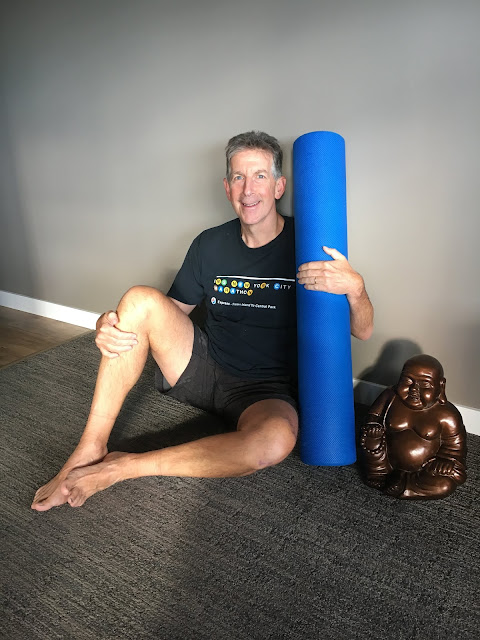Foam Rolling for Runners
 |
| Foam rolling can help the runner both warm-up and recover |
While research indicates no clear benefit, I use and find value in foam rolling to warm-up for a run and to recover from training (especially to recover after overdoing it in training). And if you overdo it in training, it’s always good to consult with a health professional before foam rolling.
As shown in the picture above, the foam roller I use is at least 10 years old. I think any type of roller you can acquire will be fine. These days one can even purchase a foam roller from their local supermarket. I’ve even used an empty wine bottle to roll!
Foam rolling gets at not just fascia but also muscles, nerves, and other connective tissue. I think of rolling as squeezing a sponge, then allowing the body area being rolled to fill again with water - squeeze out stiffness and allow relaxation and fluid to enter. As shown below, body areas that I focus on are: calves (for runners needs regular attention), “wake up” the hamstrings/glutes, quads/hip flexors and upper back (due to sitting and/or on the computer for long periods of time).
Roll each of these areas gently and slowly, while at the same time taking deep breaths. Your body generally tells you what areas need attention. Roll from the middle of the muscle toward the insertion of a joint, while avoiding rolling the actual joint. When you come across a tight area, slowly roll out this “knot'' by massaging above and below the area with the roller, for at least 10 seconds. It’s good to keep in mind that rolling shouldn’t be rushed or rough.
Calves
 |
| Make sure to foam roll the Achilles tendon, then turn your feet outward to roll the outside of your lower leg and the tendon prominent there. |
Hamstrings / Glutes
 |
| Roll over hamstrings and glutes and take time on stiff and sore spots. Sometimes a stiff muscle may be located deep in the pelvis, like the piriformis muscle. |
Quads / Hip Flexors
 |
| Roll over quads and hip flexors and take time on stiff and sore spots, especially those tight hip flexors. |
Upper Back
 |
| Position foam roller on spine of upper back, so your head is contacting the floor and keep arms close to/touching the floor. |
In addition to foam rolling, some additional tips for maintaining comfortable, fluid movement:
-Stay hydrated
-Eat healthy fats for keeping fascia and tendons well-oiled.
-Maintain movement and mobility throughout the day.
-When possible, soak in warm water to keep fascia and tendons loose.
* * * * *
As mentioned in this post, foam rolling can help runners recover from training, especially to recover after overdoing it in training or racing. If you're interested in more posts on recovery and running check out "Recovery from Training & Racing" found in the EOOC TABLE OF CONTENTS page located in the sidebar of the homepage.
Thanks for reading!
QUESTION?
info@experiment1coaching.com
WEBSITE
Experiment of One Coaching covers topics ranging from running, strength training, health & wellness, sports nutrition to travel.
Comments